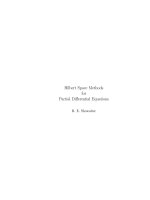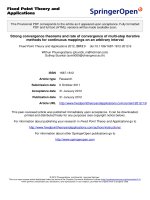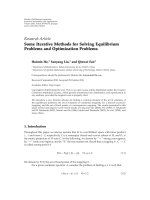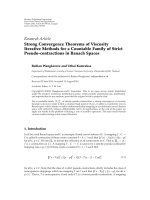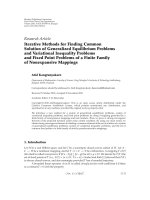Iterative methods for solving nonlinear equations with fourth-order convergence
Bạn đang xem bản rút gọn của tài liệu. Xem và tải ngay bản đầy đủ của tài liệu tại đây (261.07 KB, 8 trang )
ITERATIVE METHODS FOR SOLVING
NONLINEAR EQUATIONS WITH
FOURTH-ORDER CONVERGENCE
Jivandhar Jnawali*
Chet Raj Bhatta
ABSTRACT
In this paper, we obtain fourth order iterative method for solving
nonlinear equations by combining arithmetic mean Newton method,
harmonic mean Newton method and midpoint Newton method uniquely. Also,
some variant of Newton type methods based on inverse function have been
developed. These methods are free from second order derivatives.
Key Words: Newton method, nonlinear
convergence, inverse function, iterative method.
equation,
fourth-order
INTRODUCTION
Nonlinear equations play important role in many branches of science
and engineering. Finding an analytic solution to nonlinear equations is not
always possible. So finding numerical solution of nonlinear equations become
important research in numerical analysis. In this paper, we consider the
iterative methods to find the simple root of nonlinear equations
( ) = 0
where
(1)
∶ ⊂ → for an open interval
is a scalar function.
One of the most widely used numerical method is Newton method
=
−
(
(
)
)
(2)
This is an important and basic method (Bradie, 2007) which converges
quadratically. In the recent years, a tremendous variant of this method has
appeared showing one or the other advantages over this method in some sense.
DEFINITION: (Weerakoon and Fernando, 2002).If the sequence
| ≥ 0}tends to a limit in such a way that
*
Mr. Gnawali is Reader in Mathematics at Ratna Rajyalaxmi Campus, Tribhuvan University,
Kathmandu, Nepal and Dr. Bhatta is Professor in Mathematics at Central Department of
Mathematics, Tribhuvan University, Kirtipur, Kathmandu, Nepal.
66
ITERATIVE METHODS FOR SOLVING...
lim
→
(
−
= ,
− )
for some ≠ 0 and ≥ 1, then the order of convergence of the sequence
is said to be and is known as asymptotic error constant.
When = 1, the convergence is linear, and it is called the first
order convergence. If = 2 and = 3, the sequence is said to converge
quadratically and cubically respectively. The value of is called the order
| ≥ 0}.
of convergence of the method which produce the sequence
=
− is the error in th iterate. Then the relation
Let
=
+ (
)
is called the error equation for the method, p being the order of
convergence.
DEFINITION: (Singh, 2009). Efficiency index is simply define as
,
where p is the order of convergence of the method and m is the number of
the function evaluations required by the method per iteration. The
efficiency index of Newton method is 1.41 and secant method is 1.62.
SOME VARIANT OF NEWTON METHOD
Weeraken and Fernando (2000) used the Newton’s theorem
( )= (
)+
( )
(3)
and approximate the integral by trapezoidal rule that is
( )
=
(
)
[ (
)+
( )].
(4)
Then we obtained the variant of Newton method which is given by the
formula
=
∗
where
=
−
−[
(
(
(
)
.
)
(
)
)
,
( ∗ )]
The method (5) can be written as
=
−
[
(
(
)
)
( ∗ )]
(5)
TRIBHUVAN UNIVERSITY JOURNAL, VOLUME. XXX, NUMBER 2, DECEMBER 2016
67
This method is called arithmetic mean Newton method since this
variant of Newton method can be viewed as obtained by using arithmetic
mean of ( ) and ( ∗ ) instead of ( ) in Newton method (2). If
we approximate the indefinite integral in equation (3) by using the
harmonic mean ( zban, 2004; Ababneh, 2012) that is if we use the
harmonic mean instead of the arithmetic mean in equation (3), we get
=
(
−
(
)
(
)
)
( ∗)
( ∗)
(6)
Also if we approximate the indefinite integral in equation (3) by midpoint
rule (Ababneh, 2012; Jain, 2013)
( )
=( −
+
2
) ′
We obtain the iterative formula
=
where
∗
=
(
−
−
(
(
)
∗
,
(7)
)
.
)
This method is called midpoint Newton (MN) method.
COMBINATION OF METHODS
Multiplying equation (5), (6), (7) by
adding, where + + = 1, we get
=
2 ( )
( ∗) + (
−
+
where
∗
=
−
(
(
)
.
)
(
∗)
+
(
,
,
respectively and
)[ ( ) +
2 ( ) (
(
∗)
∗ )]
)
∗
(8)
We shall prove here that all the methods given by families of method (8)
are of order at least 3 and for unique values of a, b, c, the resulting method
is of order 4. We begin with the following:
68
ITERATIVE METHODS FOR SOLVING...
THEOREM: Let the function has sufficient number of continuous
derivatives in a neighborhood
which is a simple zero of ,that is,
( ) = 0, ( ) ≠ 0. Then, all the methods given by the family of
=
method (8) are of order 3 and for unique value of
, = 1, = ,
we get the method is of order 4.
Proof. Let be a simple root of f (x) = 0 (i.e. ( ) = 0 and ′( ) ≠ 0)
and be the error in thiterate. Then using the Taylor's expansions and after
some calculation ( zban, 2004; Weerakoon and Fernando, 2012), we get
(
)
(
[
(
)
( ∗ )]
(
)
)
)
=
−
( ∗)
)
(
=
=
∗)
(
+
+ (
+ (
−
)
(9)
),
(10)
and
(
=
where
∗
!
+ (
( )
,
( )
−
+ (
)
)
(11)
= 2,3, ….
Substituting the values from (9), (10) and (11) in (8), we get
=
=
−( + + )
+
+
1
+ (
4
)
+ (
−
+ −
+ (a + c)
1
2
+
1
2
−
)
+ (
)
Hence from above, rate of convergence of each method given by
the family of method (8) is at least three and we get the method is of order
four for unique value of =
, = 1, = . Thus the method for order
convergence four is
where
∗
=
=
−
(
+
(
(
(
)
)
.
)
)
(
−
( ∗)
( ∗ )]
)[ ( )
−
∗
( ) ( )
(
)
∗
,
(12)
This method (12) is same as Dehghan and Hajarian method (2010)
but they approximated the indefinite integral in Newton's theorem by linear
TRIBHUVAN UNIVERSITY JOURNAL, VOLUME. XXX, NUMBER 2, DECEMBER 2016
69
combination of trapezoidal integration rule, midpoint integral rule and
harmonic mean rule and there is no idea how they choose constants.
METHODS BASED ON INVERSE FUNCTION
In this section, we use (Jain, 2013) =
of = ( ), we obtain
( )= ( )+
( ) = g(y) instead
′( )
(13)
If we approximate the indefinite integral in (13) by harmonic mean rule,
we get
( )
=( −
(
) [
(
)
( )
.
( )]
)
(14)
Hence from (13)
( )= ( )+( −
)
2 ( ) ( )
[ ( )+ ( )]
= ( ). Now using the fact that ( ) = (
and that
where
[ ( )]
)( )=
= ( ) = 0, we obtain
=
+ 0 − (
(
) 2
(
=
−
)
,then
)
)
+
( )
( )
2 ( )
[ ′( ) + ′( )]
Thus when →
(
(
)
and in right side if we use
∗
=
=
−
we get the iterative formula
=
−[
(
(
)
)
( ∗ )]
.
(15)
This formula is exactly same as the formula (5) obtained by
approximating the indefinite integral of equation (3) using the trapezoidal
rule for the function
= ( ).
Again if we approximate the indefinite integral in equation (13) by
midpoint rule, we get
70
ITERATIVE METHODS FOR SOLVING...
( )
=( −
+
2
) ′
Hence from equation (13),
( )= ( )+( −
+ 0− (
=
+
2
) ′
1
)
Therefore iterative formula
=
∗
where
=
(
−
(
(
−
)
.
)
)
,
∗
(16)
This method is exactly same as method given
by equation (7).
Finally if we approximate the indefinite integral in equation (13)
by trapezoidal rule, we get
( )
( −
2
=
)
[ ( )+
( )]
Also from (13), we get
( )= ( )+
=
or
+
−
=
)
( −
2
(
(
[ ( )+
)
(
(
(
)
(
)
)
)
+
(
( ∗)
( )]
( )
∗)
Therefore iterative formula
where
=
∗
=
−
−
(
(
(
)
(
(
)
)
( ∗)
( ∗)
,
(17)
)
.
)
This formula is same as the formula (6) obtained by approximating the
indefinite integral of equation (3) using the harmonic mean rule for the
function = ( ). From above it is clear that the fourth-order
convergence method based on inverse function obtained by combining the
TRIBHUVAN UNIVERSITY JOURNAL, VOLUME. XXX, NUMBER 2, DECEMBER 2016
71
methods which are obtained respectively by approximating the indefinite
integral of Newton's formula by harmonic mean rule, midpoint rule and
trapezoidal rule is also given the same formula as (12).
CONCLUSION
From above discussion, it is clear that order of convergence of the
numerical method for finding the simple root of nonlinear equation
( ) = 0 obtained from the combination of arithmetic mean Newton
method, harmonic mean Newton method and midpoint Newton method is
at least three and it become four for unique combination. Also we
conclude that numerical methods obtained by using inverse function
=
( ) = ( ) instead of = ( ) and approximating the
indefinite integral in Newton's theorem by trapezoidal integration rule,
harmonic mean rule, midpoint rule are same as harmonic mean Newton
method, arithmetic mean Newton method and midpoint Newton method
respectively. Thus, the method obtained by the combination of methods
obtained by using inverse function =
( ) = ( ) instead of
= ( ) and approximating the indefinite integral in Newton's theorem by
trapezoidal integration rule, harmonic mean rule and midpoint rule is same as
method (12). This method is also free from second order derivatives.
WORKS CITED
Ababneh, O.Y. (2012). "New Newton's method with third order
convergence for solving nonlinear equations." World academy of
science and engineering and technology, 61: 1071-1073.
Bradie, B. (2007). A Friendly introduction to numerical analysis. Pearson
Education Inc., pp. 66-149.
Dheghain, M. & Hajarian, M. (2010). "New iterative method for solving
nonlinear equations fourth-order convergence." International
journal of computer mathematics, 87: 834-839.
Jain, D. (2013). "Families of Newton-like methods with fourth-order
convergence." International journal of computer mathematics, 90:
1072-1082.
Jain, P. (2007). "Steffensen type methods for solving non-linear
equations." Applied mathematics and computation, 194: 527-533.
zban, A.Y. (2004). "Some new variants of Newton's method." Applied
mathematics letters, 13: 677-682.
Singh, M.K. (2009). "A six-order variant of Newton’s method for solving
nonlinear equations." Computational methods in science and
technology, 15(2):185-193.
72
ITERATIVE METHODS FOR SOLVING...
Wang, P. (2011). "A third order family of Newton like iteration method
for solving nonlinear equations." Journal of numerical
mathematics and stochastic. 3: 11-19.
Weerakoon, S. & Fernando, T.G.I. (2002). "A variant of Newton's method
with accelerated thir d-order convergence." Applied mathematics
letters, 13: 87-93.


